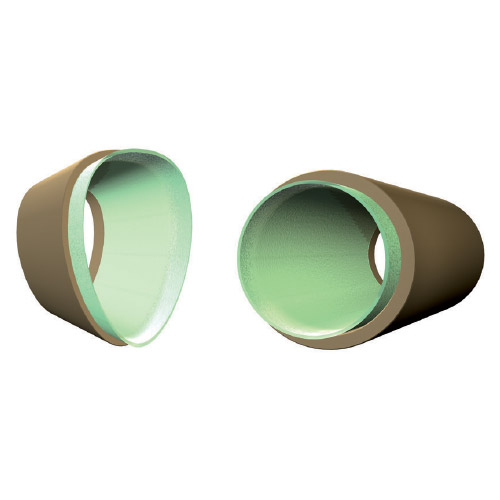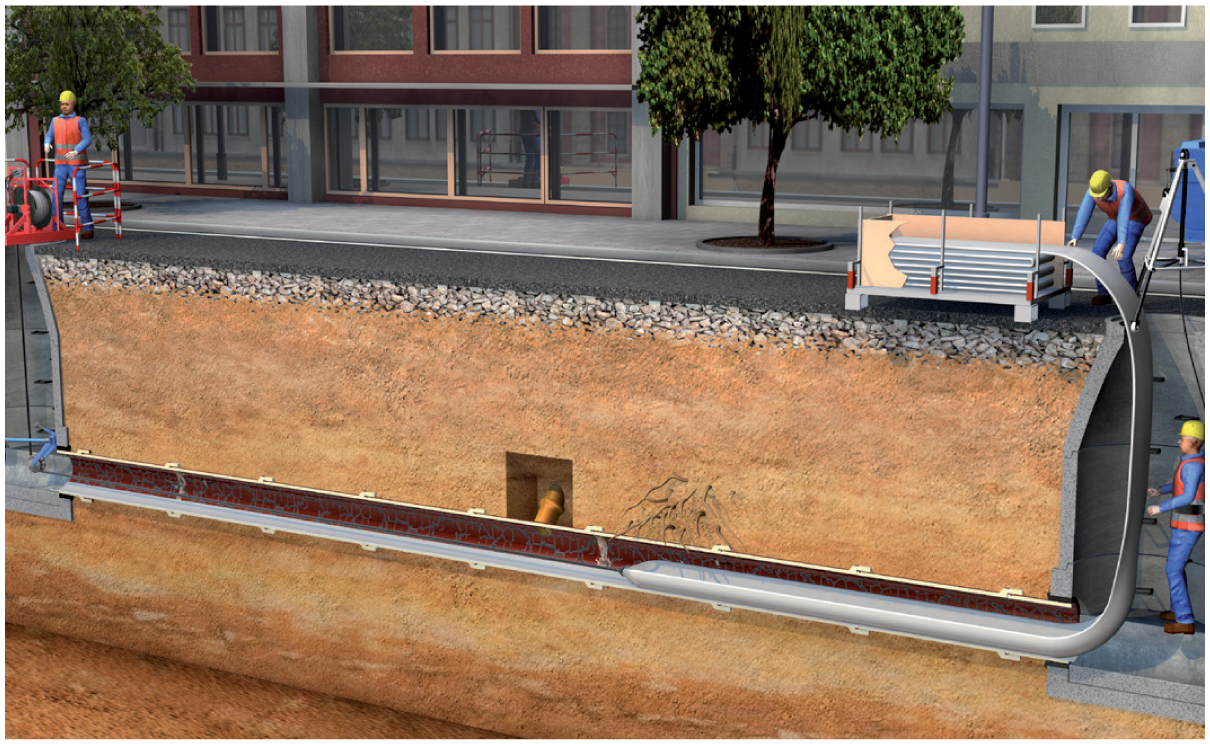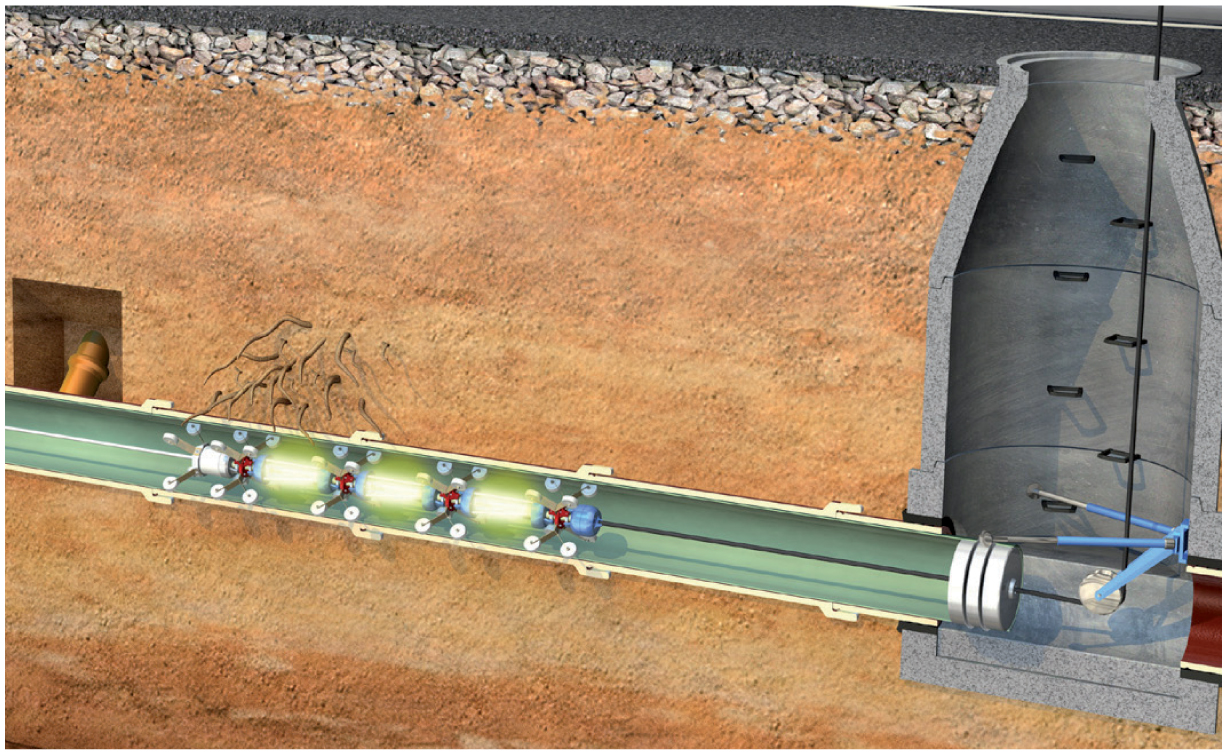Berolina-Liner System
The Berolina-Liner System sets new standards in pipe rehabilitation.
With the Berolina-Liner System, BKP has developed an innovative procedure which is very successful on the market for the efficient and economical rehabilitation of gravity pipes. The Berolina-Liner is a resin-impregnated tube that is fed through a manhole into the pipe to be renovated. The liner is cured in place thereby sealing the pipe against leakage. In addition, the- Berolina-Liner structurally reinforces the piping system. This process avoids the need for extensive excavation and only a marginal, short-term disturbance of the infrastructure around the rehabilitation site is necessary.
The energy requirement for production, transport and installation of the liner is extremely small in comparison with traditional procedures. Compared to competing systems, the Berolina-Liner System is noted for a markedly reduced CO2 emission during the installation and the curing process. The Berolina-Liner System is completed by installation equipment specially optimized for the Berolina-Liner. This is offered by BKP in different adjusted variants according to clients’ specifications. Tailor-made equipment variants make the application of the Berolina-Liner System possible at nearly any location globally.
Environmental Consciousness
Environmental Consciousness The Berolina-Liner is cured by using UV-light. This process is temperatureindependent and causes far less CO2 emissions than other curing methods. This advantage is, in turn, multiplied by the short installation times, without the need for extensive trenching and disturbance to the economic and social infrastructure. This is inexpensive and protects our environment.
Rehabilitation
After thorough cleaning, first the gliding foil and then the Berolina-Liner are winched into the host pipe. This procedure is known as the “winched in place” procedure. The two ends are closed with end cans, the tube carefully inflated with approx. 0.5 bar (7.5 psi) compressed air and pressed onto the pipe wall. In this way the outer film of the Berolina-Liner prevents contamination from soil and ground water as well as penetration of resin into the laterals. The Berolina-Liner now adapts itself positively to all changes in the cross-section and profile. Compressed air as a medium offers, among other things, the advantage that the uncured Berolina- Liner can be inspected during the drawing-in of the UV-light source with the help of a special camera. Following this, the UV-light source is ignited and drawn through the Berolina-Liner at a defined speed. The liner is thus cured by the UV-light. The inner protective film is removed afterwards.
The curing takes place emission-free with sealed-off tube endings. A new pipe is created in the host pipe within the shortest period of time and without damage to the environment. It is a stable inner lining for all customary pipe materials including brick-lined ducts. The slight cross-section loss is functionally compensated by the smooth and abrasion-tight inner chemically protective liner surface of the Berolina-Liner. The curing speeds vary according to the diameter and wall thickness of the Berolina-Liner. the UV-light. The inner protective film is removed afterwards. The curing takes place emission-free with sealed-off tube endings. A new pipe is flexibility of the Berolina-Liner allow them to be detected optically. They are then cut out immediately after the curing and the Liner can be closely bound to the lateral using customary procedures.
Glimpses Into The Rehabilitation Process
Liner Structure
The unique tube structure is integral to the outstanding quality and versatile application of the Berolina-Liner System. The Berolina-Liner consists of corrosion-resistant fiberglass complexes and/or polyester felts impregnated with high-grade polyester resin or vinylester resin arranged in an overlapping and displaced manner in relation to each other. With its variable stretching property, the seamlessly produced Berolina-Liner fits optimally into any profile, especially circular and oval profiles of diameters between 150 mm and 1,600 mm. Cross-section transitions or profile transitions pose no problems for the Berolina-Liner.
The fiberglass arranged along the lengthwise direction of the Berolina-Liner enables the absorption of all draw-in forces occurring during the liner installation. Only slight wall thicknesses are necessary due to the best mechanical parameters. Through this, cross-section loss is reduced to a minimum following the pipe rehabilitation. BKP produces the Berolina-Liner with a protective inner film and a UV-proof outer film. The Berolina-Liners are delivered wet-out and ready to install, guaranteed and usable without loss of quality 6 months at normal room temperature. The Berolina-Liners are “continuously” produced and can also be built in extremely long sections (up to 400 m).
Characteristics
The values of the Berolina-Liner, established by the “TÜV” (German Technical Monitoring Association) and the “Institute for Pipeline Construction at the Fachhochschule Oldenburg“ Ring E-module at least 10,000 N/mm² (1,450,000 psi / 10,000 MPa), tension E-module approx.14,000 N/mm² (2,030,500 psi / 14,000 MPa)
Quality Assurance

Production of the Berolina-Liner is internationally certified according to DIN EN ISO 9001:2008 and is regularly inspected by the TÜV (German Technical Monitoring Association). In order to ensure continual quality the level, we carry out detailed tests on every production batch. Alongside the good control system, inspections include a constant testing of the liner by our trained production and quality control staff. Not only the production at our plant, but also the installation of the liner on-site, is subject to a detailed quality assurance inspection such as TV inspection during and after curing using a remote camera. All installation parameters are documented. Finally, the cured liner pipe is tested.
The most important testing criteria:
1.External initial tests:
- -High pressure jetting tests according to the Hamburg Model (60 jetting processes)
- -10,000-hour fatigue tests
- -Leakage test (CP308)
- -Strain corrosion test
- -Darmstadt tilted drain experiment
- -Fire resistance test
2.Internal quality monitoring prior to delivery:
- -Functional and reactivity test
- -Impermeability test in accordance with DIN/EN 1610
- -Measurement of the wall thickness
- -Measurement of the initial annular stiffness
- -3-point bending test
- -Measurement of the resin content
- -Barcol hardness
- -Residual styrene content3.External quality supervision after installation:
- -Impermeability test
- -Measurement of the wall thickness
- -Measurement of the initial annular stiffness
- -3-point bending test
- -Measurement of the resin content
- -Residual styrene content
Other country-specific test are also carried out.
Advantages

• Construction approval by the Deutsche Institut für Bautechnik (German Institute for Construction Technology), DIBt Z-42.3-336 and other international approvals
• Production controlled and supervised by the German Technical Monitoring Association (TÜV) at our plant in Berlin in accordance with the quality standards of DIN EN ISO 9001:2008
• Worldwide ready-to-install delivery, as well as up to 6 months shelf life without loss of quality
• Double quality control through camera inspection of the Berolina-Liner before and after the curing • Less space required in the installation of the Berolina-Liner at the construction because all the equipment relevant to the installation can be stored in a single truck
• Brief installation times due to the UV -light curing
• Seamless construction and smooth surface, chemical resistant inner layer
• Suitable for all circular and oval profiles, ID 150 mm – ID 1,600 mm or other simular profiles
• Cross-over of profile and cross-section exchanges is possible
• Highest mechanical parameters due to fiberglass reinforcement; for this reason, only thin wall thicknesses are necessary and there is minimal cross-section loss after the rehabilitation
• Selection of material according to requirements
• Reduction of waste products due to the curing procedure (e.g. no process water)
• Ordering according to stiffness classes
• Reduced energy requirements during production, transport and installation
• Complete opening of the laterals is possible immediately after the curing of the liner For All Customary Pipe Profiles



